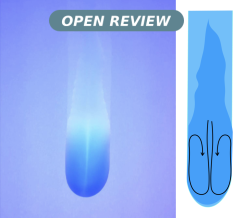The wetting properties of frosted glass
DOI:
https://doi.org/10.4279/pip.130006Keywords:
droplet, frosted glass, rough surface, wetting, open microfluidicsAbstract
Frosted glass is a common, low cost material. Its roughness can be used to control how it is wet by water. In this paper, the wetting properties of silicone oil and water are investigated. For the oil, wetting is total since the oleophilic character of the glass is enhanced by its roughness. Due to the remarkable optical properties of frosted glass, the spreading of oil droplets on its surface was recorded over three months. Frosted glass is a parahydrophilic surface because of its large contact angle hysteresis (up to 80° ). The behaviour of oil and water droplets was compared on a long piece of inclined frosted glass. The trajectories (and the spreading) of the droplets were studied and phenomenological laws were deduced to describe the dependence of the droplet speed on the initial volume of the droplet and the angle of inclination. Such dependences of speed at long travel distances (100 times the capillary length) were deduced and rationalised with a simple model that takes into account the thickness of the wake. Moreover, we analysed the flow inside the wake of water droplets sliding on inclined frosted glass. Suggestions are given on how to exploit drainage of the water droplet wake and the high hysteresis of water within the framework of open microfluidics.

Downloads
Published
Versions
- 2021-12-01 (2)
- 2021-12-01 (1)
How to Cite
Issue
Section
License
Copyright (c) 2021 stéphane dorbolo

This work is licensed under a Creative Commons Attribution 4.0 International License.
Authors agree to the PIP Copyleft Notice













